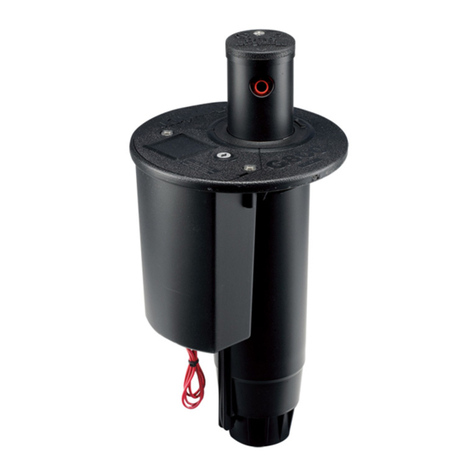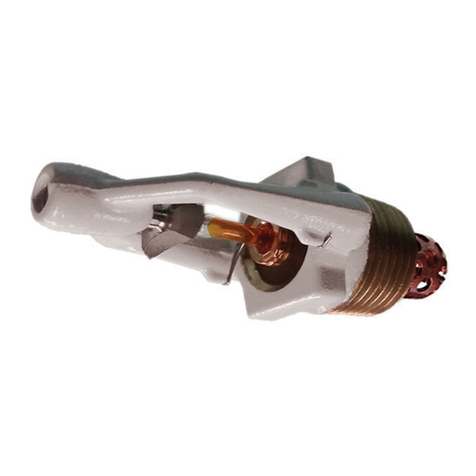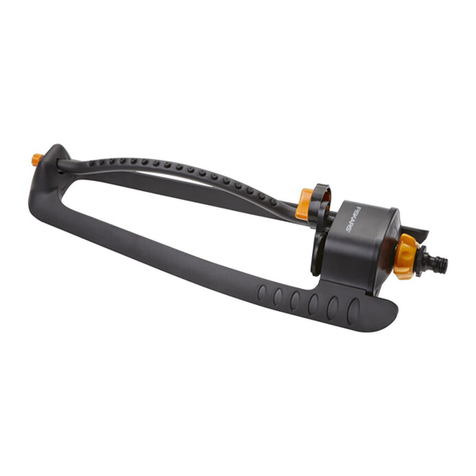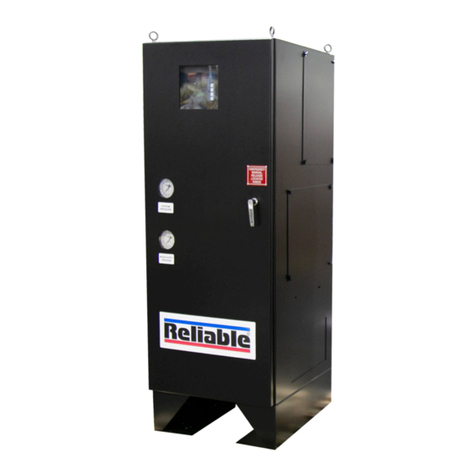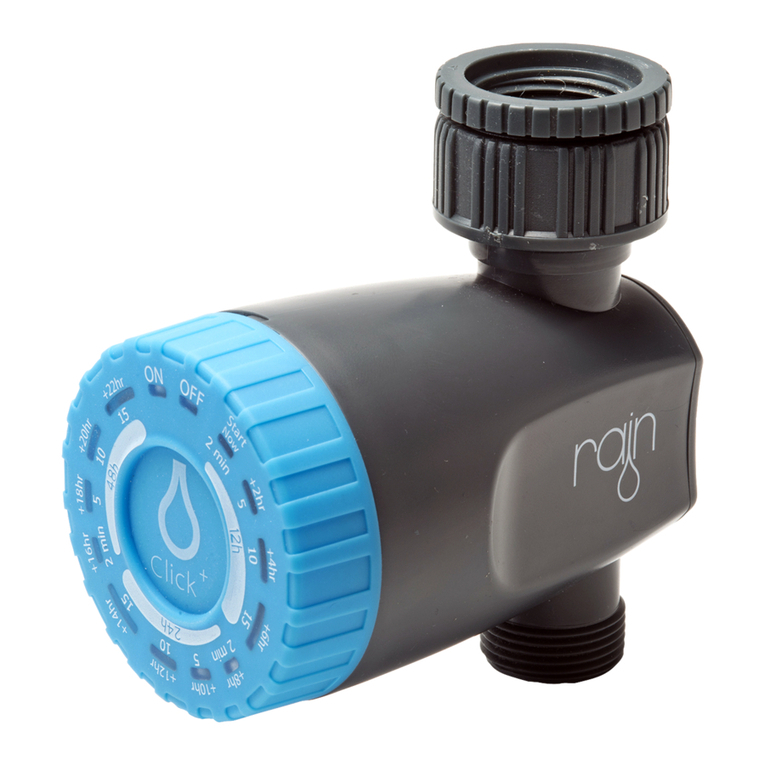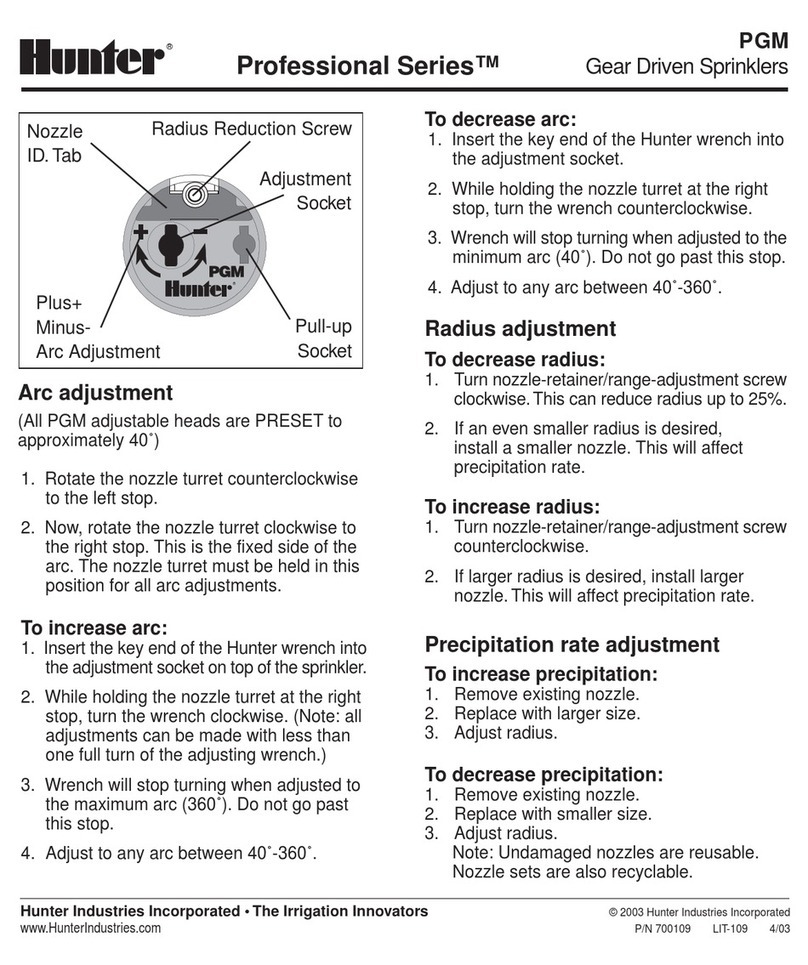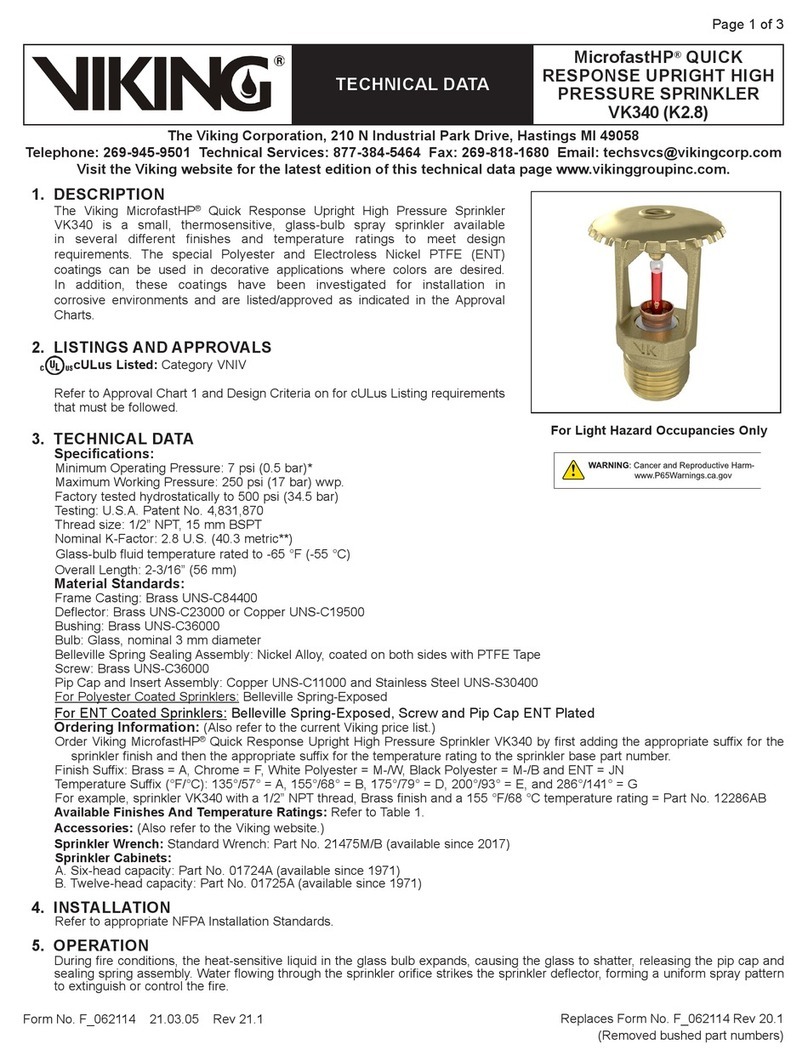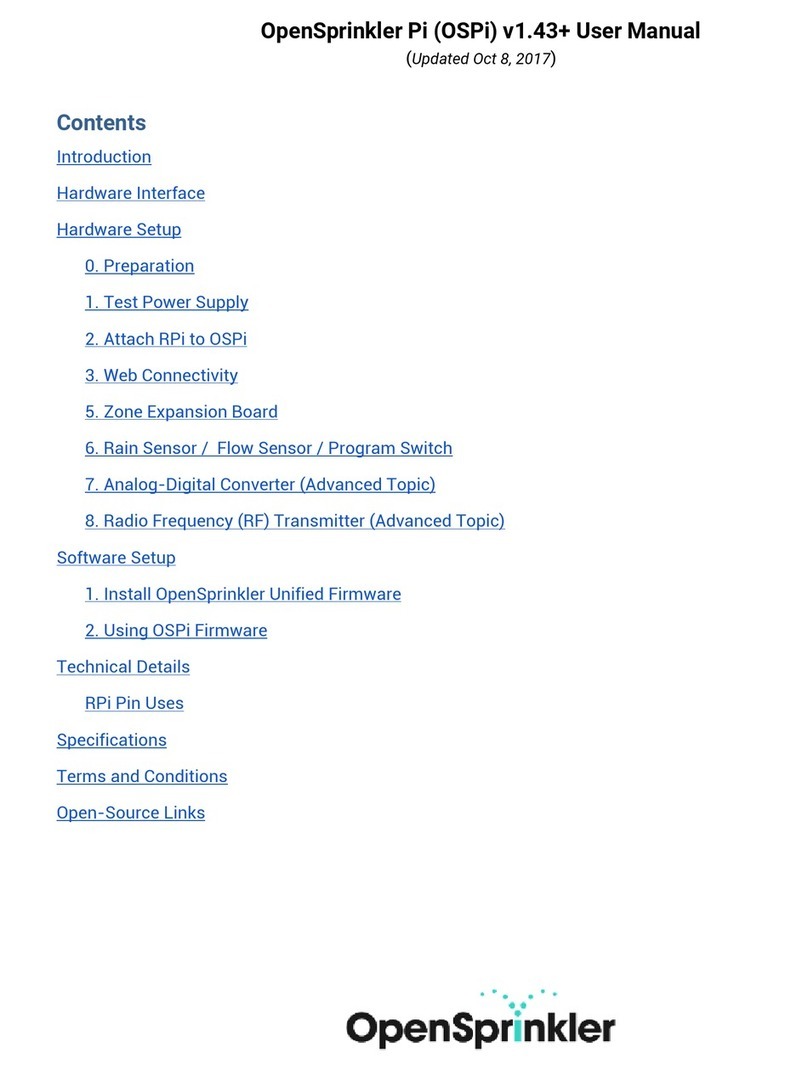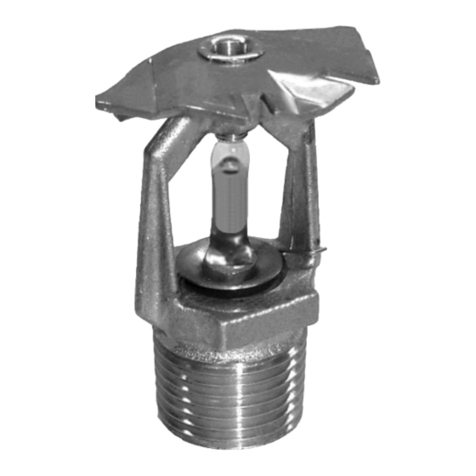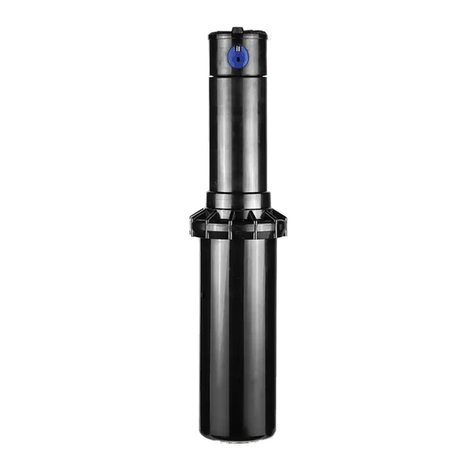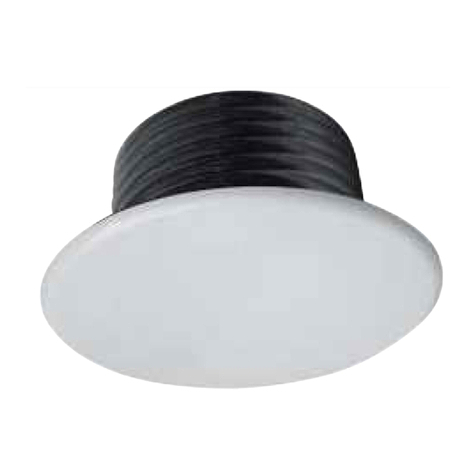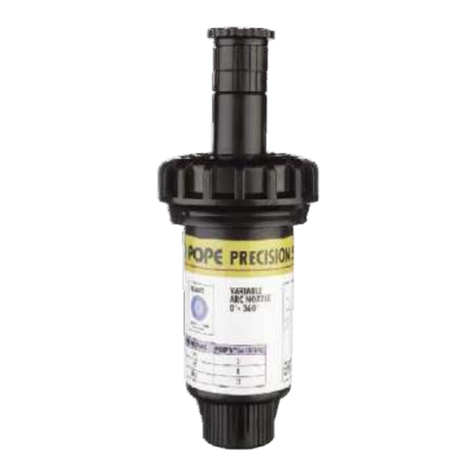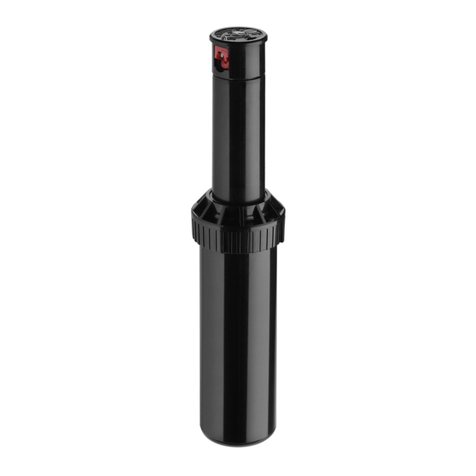HI-FOG 1900 Manual

18/09/2017
Document number 0003301084 Ver. A Page 1 of 18
HI-FOG® 1900 SPRINKLER
WITH
A1000 TYPE ASSEMBLY BODY WITH STOP VALVE
IDENTIFICATION AND CORRECTION PROCEDURE
The purpose of this document is to provide guidance and instructions for corrective
actions required to mitigate the risk of HI-FOG 1900 sprinkler installed in some
A1000 type assembly bodies with an internal stop valve as referred to in Safety
Bulletin 2017\004.
The information in this document is in the following order:
Introduction and General Work Instructions
1. Background information
2. Affected and other HI-FOG sprinkler types
3. Affected and other Assembly Bodies
4. Corrective Actions
5. Troubleshooting
Appendix A: Follow-Up form
Appendix B: Summary of Product Types Differences
CAUTION
HI-FOG Systems comprise mechanical components
and employ high-pressure for water pressurization.
System installation embraces high-pressure testing of discharge tubing.
Care must be taken to ensure that in the installation all relevant procedures are
followed to the satisfaction of the authority having jurisdiction
and that only competent personnel, appropriately trained, are
permitted to install, test, commission and service the system.

18/09/2017
Document number 0003301084 Ver. A Page 2 of 18
1. Background information
Installation of HI-FOG sprinklers consists of HI-FOG sprinkler inserted into a
specifically built Assembly Body, also known as ‘Mounting Adaptor’.
Figure 01 : HI-FOG sprinkler in Assembly Body
The A1000 Assembly Bodies were built to accommodate the HI-FOG 1000
sprinklers. Some types of this Assembly Body include an internal stop valve that
prevents the flow through the Assembly Body if the sprinkler is removed.
The HI-FOG 1900 sprinklers have been developed as replacement of HI-FOG
1000 sprinklers using some of the improvements presented in the HI-FOG 2000
sprinklers.
For some of the Assembly Body type A1000, there is a risk that a HI-FOG 1900
sprinkler will press the internal stop valve beyond the intended range and thus
may diminish or in the worst case prevent the water flow to the sprinkler in case of
discharge.
The risk is limited to the specific Assembly Body types, used in combination with
HI-FOG 1900 sprinklers.
The risk does not extend to other Assembly Body types, to Assembly Bodies
without internal stop valve or to any other HI-FOG sprinklers with any Assembly
Body.
See details in the following sections to identify the affected components.

18/09/2017
Document number 0003301084 Ver. A Page 3 of 18
2. Affected and other HI-FOG sprinkler types
The risk and the related corrective action required are relevant for HI-FOG 1900
sprinklers only.
Other HI-FOG sprinkler types require none of the actions referred to by this
document.
To differentiate the HI-FOG 1900 sprinkler from other HI-FOG sprinkler types
note the following features:
a. HI-FOG 1000 sprinkler have a similar conical shape as the HI-FOG 1900,
but the HI-FOG 1900 has a groove above the conical section while the
HI-FOG 1000 does not.
b. HI-FOG 2000 and HI-FOG 3000 sprinklers do not have a conical section
c. Other types, such as pop-up or machinery-space open spray-heads, that are
not included in the illustration below, do not have a glass bulb.
HI-FOG 1900
HI-FOG 1000
HI-FOG 2000
HI-FOG 3000
Appearance:
-Cone shape
-Groove above the
cone
Appearance:
-Cone shape
-No groove
Appearance:
-No cone
-No groove
Appearance:
-No cone
-No groove
Action Required No Action Required
Figure 02 : HI-FOG sprinkler types

18/09/2017
Document number 0003301084 Ver. A Page 4 of 18
3. Affected and other Assembly Bodies
The risk and the related corrective action required are relevant only for HI-FOG
1900 sprinklers (see Chapter 2 to identify) when installed in some A1000 types
Assembly Body, which contain an internal stop valve.
HI-FOG sprinkler installed in other types of Assembly Body require none of the
actions referred to by this document.
To differentiate the A1000 Assembly Body from other Assembly Body types note
the following:
a. With the A1000 type Assembly body there is no gap between the HI-FOG
1900 sprinkler and the cover plate when the HI-FOG 1900 sprinkler is
installed (see Figure 01). The cover plate (see Figure 01) of A1000
Assembly body types is held in place by the sprinkler.
b. The A2000 Assembly body type is suitable only for HI-FOG 2000 sprinklers
(see Figure 02 for sprinkler types).
c. A HI-FOG 1900 sprinkler installed in an AB type Assembly body would either
leave a 2 – 3 mm gap between the top of the sprinkler and the cover plate,
or would have an adaptor ring filling the gap.
See Figure 03 for AB types below – left half without adaptor ring and right
half with adaptor ring. The cover plate of AB type is connected to the
Mounting Adaptor with a lock ring.
d. The Ctype the installation with HI-FOG 1900 sprinkler would leave a narrow
gap between the top of the sprinkler and the cover plate - The cover plate of
Ctype is snapped directly to the Assembly body.
A1000 types
A2000 types
AB types
C types
Notes:
-Cover plate
supported by the
sprinkler : no gap
Notes:
-Cover plate
supported by the
sprinkler : not
applicable for HF
1900
Notes:
-Cover plate
supported by lock
ring : gap or
adaptor ring
Notes:
-Cover plate
snapped to the
Assembly Body :
gap
Action Required
for HI-FOG 1900
No Action Required
Figure 03 : Assembly Body types

18/09/2017
Document number 0003301084 Ver. A Page 5 of 18
4. Corrective Actions
As corrective action the O-ring needs to be replaced and a spacer plate needs to
be added to each HI-FOG 1900 sprinkler installed in A1000 type assembly body
with an internal stop valve.
Note: These instructions are intended for HI-FOG systems with electric
powered pump units.
For GPU (Gas-driven Pump Units) please contact Marioff for system
specific instructions.
4.1. Required Documents and Tools
To assure all affected sprinklers are addressed, it is recommended to prepare a
work plan before starting the work.
The following documents are recommended to be used in the process:
•HI-FOG sprinkler layout drawing to provide the locations of all potentially
affected sprinklers, section valves and flushing valves which will be used
during the modification process.
Please note that even though the HI-FOG sprinkler layout drawings indicate
HI-FOG 1000 sprinklers they may have been replaced by HI-FOG 1900
sprinklers during testing or service.
•Appendix A of this document contains a follow-up table for the checking and
adjusting of sprinklers.
Required parts:
•Spacer Ring, Marioff item code 2000267114
•O-Ring 15x2,0, Marioff item code 2000297566
Spacer plate
O-Ring 15x2,0
Figure 04 : Required parts
Required tools (see Figure 05 for details):
•O-Ring assembly tool; item code 2000297565
•Sprinkler key; item code M11015 or Sprinkler dismounting tool; item code W-
0010888
•Flushing hose; item code M14510 or Section valve test hose; item code
D23050 or Section valve test hose; item code D23040
•Buckets and rags as some spillage is expected when removing and
reinstalling the sprinklers

18/09/2017
Document number 0003301084 Ver. A Page 6 of 18
•Ladder
•Scaffolding where needed
Sprinkler key
item code M11015 Sprinkler dismounting
tool item code W-
0010888
Flushing hose
item code M14510
Section valve test hose item code
D23050 Section valve test
hose item code
D23040
O-Rings assembly
tool item code
2000297565
Figure 05 : Tools
4.2. Preparations
Note: HI-FOG 1900 sprinklers can also be found as spare parts in storage.
Make sure that also the spare HI-FOG 1900 sprinklers are included in the
work plan.
Identify and log the location of all installed HI-FOG 1900 sprinklers. Use the HI-
FOG sprinkler layout drawings as indication of potential locations of HI-FOG
1900 sprinklers (remember that HI-FOG 1900 sprinklers are replacements of HI-
FOG 1000 sprinklers) and confirm the type visually (see Chapter 2 for details).
Identify and log the type of assembly body whenever possible by visual
inspection (see Chapter 3 for details).
After mapping the location of all potentially affected HI-FOG 1900 sprinklers
which are mounted to A1000 type Assembly bodies, prepare a work plan that will
assure all affected sprinklers will be taken into account when performing the
corrective actions.
Before starting the work, inform the bridge and ECR that the HI-FOG system is
partly out of operation during corrective actions to avoid accidental alarms!

18/09/2017
Document number 0003301084 Ver. A Page 7 of 18
4.3. Performing corrective actions
4.3.1. Isolate the Accumulator Units
Before starting corrective actions, switch on the Nitrogen
blocking from the key switch on the control panel or disconnect
the nitrogen accumulator unit (if applicable) to avoid the
accidental release of nitrogen (see
Figure 06
and
Figure 07
).
Figure 06 : Disconnecting the solenoid plug from a Bürkert valve
Figure 07 : Disconnecting the solenoid plug from a release valve
4.3.2. Isolate and de-pressurize the section under work
Before removing the sprinklers it is advisable to isolate (see a below) and
depressurize the section where the HF1900 sprinklers will be modified to
minimize the risks of spillage and false starting of the pump unit.
Depressurizing the section can be done either from the Flushing Valve (see b
below) or from the Section Valve (see c below).

18/09/2017
Document number 0003301084 Ver. A Page 8 of 18
Figure 08 illustrates the schematic view of a typical section:
Figure 08 : Schematic view of a typical section
a. Before depressurizing the section, make sure the section where corrective
actions are being carried out is isolated by closing the section valve as
illustrated below. (see Figure 09 ).
Note: Use your hands only to manually open or close the valve. Excessive
force is not required and should not be used.
SBA section valve
SVA section valve
Figure 09 : Section valves
b. The section can be depressurized from the flushing valve with a flushing
hose (see Figure 05 ). The flushing valves of the sections should be marked
on the HI-FOG sprinkler layout drawings. Flushing valves are equipped with
a flushing valve sign (see Figure 10 ).
Minimess connection
point

18/09/2017
Document number 0003301084 Ver. A Page 9 of 18
Figure 10 : Flushing valve sign
-Connect the flushing hose to the flushing valve.
-Point the hose towards a sewer or a drain. Hold the hose firmly with
both hands.
-Open the flushing valve.
-Let the water flow through long enough for the section to de-
pressurize.
-Close the flushing valve.
-Disconnect the flushing hose from the flushing valve.
c. The section can also be depressurized by connecting a test hose (see
Figure 05 ) to the test valve of the section valve (see Figure 09 ). Hose item
code D23050 is suitable for SBA valves and D23040 fits to the ‘Minimes’
connection on SVA valves.
-Connect the test hose to the section valve’s test valve connection.
-Point the hose towards a bucket or drain.
-Slowly open the test valve connection.
-Let water flow through long enough for the pressure to fully release.
-Close the test valve.
-Disconnect the hose.
4.3.3. Inspect and retrofit potentially affected Sprinklers
a. Confirm that the Sprinkler is of type HI-FOG 1900 (see Chapter 2)
Log the type and location of sprinkler in the Follow-Up sheet (
Appendix A )
Figure 11 : Location and type of sprinkler
b. Inspect the Assembly Body. If it is visually identified as other type than
A1000 (see Chapter 3) then log the type in the follow up sheet (see Figure

18/09/2017
Document number 0003301084 Ver. A Page 10 of 18
12 ) and continue to the next sprinkler, there are no corrective actions
needed.
Figure 12 : Assembly Body type
c. In case the Assembly Body cannot be visually identified, or is identified as
A1000, remove the sprinkler by opening it with the correct sprinkler key or
with a sprinkler dismounting tool (see Figure 05 ).
-Do not use excessive force or you might damage the sprinkler cage.
-Use a rag or a bucket when removing the sprinkler to catch water
collected in the assembly body.
d. Inspect the Assembly Body. If it is NOT type A1000 (see Chapter 3) then log
the type in the follow up sheet (see Figure 12 ) and continue to the next
sprinkler.
If the type is A1000 then verify from the inside of the assembly body if
there is an internal stop valve (see Figure 13).
Pin type internal stop valve
Ball type internal stop valve (not in A1000 \
A2000 \ AB type Assembly Bodies)
Figure 13 : Internal stop valve
Log the type and existence \ absence of internal stop valve in the follow up
sheet (see Figure 12 ).
If there is NO internal stop valve, reinstall the sprinkler (go to step gbelow).
If the type is A1000 AND there IS an internal stop valve then continue:
e. Remove the 15x1,5 O-ring from the sprinkler (see Figure 14 ). Do not
damage or scratch the sprinkler’s sealing surface. Cut the removed O-Ring
to assure it does not mix with the new seals.
Note: to avoid damage to the sealing surface do not use any metal tools for
removing the O-Ring
f. Install the new 15x2,0 O-ring to the sprinkler by placing the O-ring
installation cone (see Figure 05 ) over the spindle and rolling the new O-ring
onto the sprinkler until you are sure the O-ring sits correctly in its groove
(see Figure 14 ).
g. Install the spacer to the sprinkler (see Figure 14 ).

18/09/2017
Document number 0003301084 Ver. A Page 11 of 18
15x2,0 O-ring to replace the 15x1,5 O-
ring supplied with sprinklers
Spacer plate to be assembled on the HI-
FOG 1900 sprinkler
Figure 14 : Replacement of O-Ring and installation of Spacer
h. Install the sprinkler and the cover plate back into place. Tighten it with the
sprinkler key. Do not use excessive force.
Log in the follow-up sheet:
-Is a cover plate (see Figure 15) present (yes/no)
-Date of changing the O-Ring \ installing the spacer plate
NOTE: Do not use excessive force when tightening the sprinkler to avoid
damaging the sprinkler.
Figure 15 : HI-FOG 1900 installed with (left) & without (right) a spacer
i. Remember to fill the record in the Follow-Up form before proceeding. Repeat
the steps above until all potentially affected sprinklers in the section are
corrected.
4.3.4. Pressurize and Flush the Section
After all sprinklers in the section have been addressed the section needs to be
engaged to the system and the functionality of the section valve should be
tested.
a. Man the testing positions:
-Person A: at the control panel or mimic panel where you can reset the
system
-Person B: in the protected compartment or holding the flushing hose
-Person C: at the flushing valve or section valve
b. Open the section valve. The pump unit may start. Wait for it to reach 130
bars and reset the system by pressing the ‘reset’ button for two seconds.
(Person A)

18/09/2017
Document number 0003301084 Ver. A Page 12 of 18
c. Check that the system stabilizes to stand-by pressure (25 bars if not
otherwise indicated). (Person A)
d. Check that there are no leaks from the installed sprinklers. (Person B and C)
e. Remove the plug from the flushing valve and connect the flushing hose to
the flushing valve. Make sure that you can hold the flushing hose firmly with
both hands during the system flushing and point it to a place where water
can be safely sprayed. (Person B and C)
NOTE: The water exits the hose with high pressure. Be sure that you can
hold the hose firmly with both hands!
f. Open the flushing valve to create flow in the system. (Person C)
g. The pump unit should activate within 1 minute.
h. Check from the control / mimic panel or the ship automation system that the
pump unit starts and verify that the correct section gives the correct alarm.
Reset the audio alarm from the buzzer reset/acknowledge button. (Person
A)
i. Let water flow from the hose for a couple of minutes to flush the section.
(Person B and C)
j. Close the flushing valve. (Person C)
k. Reset the system from the control panel after the flushing valve has been
closed and the system has reached 130 bars pressure. (Person A)
l. Check that the system stabilizes to stand-by pressure (25 bars if not
otherwise indicated). (Person A)
m.Disconnect the flushing hose from the flushing valve and install the plug
back into place. (Person C)
After competing these steps proceed to the next section in the work plan.
4.4. Post Actions
After finalizing the corrective actions in all sections, the system should be put
back into normal standby mode and the nitrogen accumulator unit should be
switched back on / reconnected. (see Figure 06 and Figure 07 ).
NOTE: Make sure that there is no activation demand on for the HI-FOG
system before reconnecting the nitrogen accumulator units!
-Inform the bridge and ECR that the work is completed and the system is
in normal stand-by mode.
Send the filled Follow-Up form to Marioff quality@marioff.fi

18/09/2017
Document number 0003301084 Ver. A Page 13 of 18
5. Troubleshooting
5.1. Leakage of retrofitted or reinstalled sprinkler
Leakage can be caused e.g. when the O-ring is not replaced and the Spacer
plate is used, when the O-ring is damaged or misplaced, or when the sealing
surface on the sprinkler or the Assembly Body is scratched or contaminated.
Corrective actions:
-Depressurise the system
-Remove the sprinkler and make sure that all the surfaces of the
sprinkler and the Assembly Body are clean and undamaged
-Replace the O-Ring and make sure it sits properly in its groove
5.2. Assembly Body type is not visibly like the listed types
The Safety Bulletin and this document focus on the relevant types, which are
connected to the ceiling by assembly plates, and to several similar models.
Other types, e.g. models that are wall mounted, or that are bolted directly to the
surface, do not require further action.
Exposed A1000 Assembly Bodies, with no cover plate, do require attention.
See Figure 16below for more examples.
A1000 Assembly body
without cover plate
Action as other A1000
Grooved Assembly body
type
No Action Required
Long Assembly body type
No Action Required
Welded Tube Assembly
body type
No Action Required
Wall Mounting Assembly
body type
No Action Required
Surface Assembly body
type
No Action Required
Figure 16 : more Assembly Bodies

18/09/2017
Document number 0003301084 Ver. A Page 14 of 18
5.3. Cover plate missing
Assembly Body type A1000 with or without cover plate (see Figure 01) needs to be
addressed in the same manner.

18/09/2017
Document number 0003301084 Ver. A Page 15 of 18
Appendix A : Follow-Up form
SITE DATA
Ship
IMO no.
Sprinkler
Location
Assembly body
Code*
Deck
Section
Type**
stop valve
[y/n]
Change
Date***
e.g.
C-0006881
Deck 5
S017
A1000
Y
21.Sep.17
e.g.
C-0009072
Spare part
stock
-
-
22.Sep.17
1
2
3
4
5
6
7
8
9
10
11
12
13
14
* Item Code of a sprinkler is a series of letters and digits, starting with ‘C’, printed on the side of HI-
FOG 1000 \ 1900 sprinklers
** Type : A1000 \ A2000 \ AB \ C (see Figure 03 )
*** date of installing replacement O-Ring and Spacer OR ‘X’ if replacement not done

18/09/2017
Document number 0003301084 Ver. A Page 16 of 18
Sprinkler
Location
Assembly body
Code*
Deck
Section
Type**
stop valve
[y/n]
Change
Date***
e.g.
C-0006881
Deck 5
S017
A1000
Y
21.Sep.17
e.g.
C-0009072
Spare part
stock
-
-
22.Sep.17
15
16
17
18
19
20
21
22
23
24
25
26
27
28
29
30
31
32
33
34
…

18/09/2017
Document number 0003301084 Ver. A Page 17 of 18
Appendix B : Summary of Product Types Differences
HI-FOG 1900
HI-FOG 1000
HI-FOG 2000
HI-FOG 3000
Appearance:
-Cone shape
-Groove above the
cone
Appearance:
-Cone shape
-No groove
Appearance:
-No cone
-No groove
Appearance:
-No cone
-No groove
Action Required
No Action Required
Figure 02 : HI-FOG sprinkler types
A1000 types
A2000 types
AB types
C types
Notes:
-Cover plate supported by
the sprinkler : no gap
Notes:
-Cover plate supported by
the sprinkler : not
applicable for
HF1900
Notes:
-Plate supported by snap-ring
: gap or spacer
Notes:
-Cover plate snapped to
the Assembly Body with a
lock ring : gap
Action Required for HI-
FOG 1900
No Action Required
Figure 03 : Assembly Body types

18/09/2017
Document number 0003301084 Ver. A Page 18 of 18
15x2,0 O-ring to replace the 15x1,5 O-
ring supplied with sprinklers
Spacer plate to be assembled on the
HI-FOG 1900 sprinkler
Figure 14 : replacement of O-Ring and installation of Spacer plate
Figure 15 : HI-FOG 1900 installed with (left) & without (right) a Spacer
plate
A1000 Assembly body
without cover plate
Action as other A1000
Grooved Assembly body type
No Action Required Long Assembly body type
No Action Required
Welded Tube Assembly body
type:No Action Required
Wall Mounting Assembly body
type:No Action Required
Surface Assembly body type:
No Action Required
Figure 16 : more Assembly Bodies
Pin type internal stop valve
Ball type internal stop valve (not in A / AB
type Assembly Bodies)
Figure 13 : internal stop valve
Table of contents
